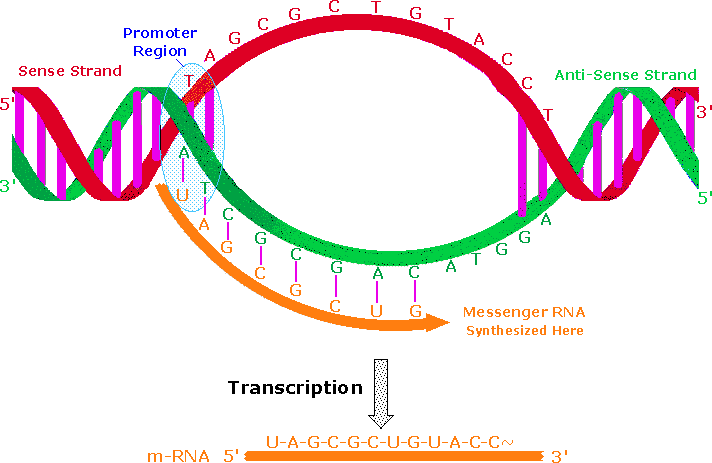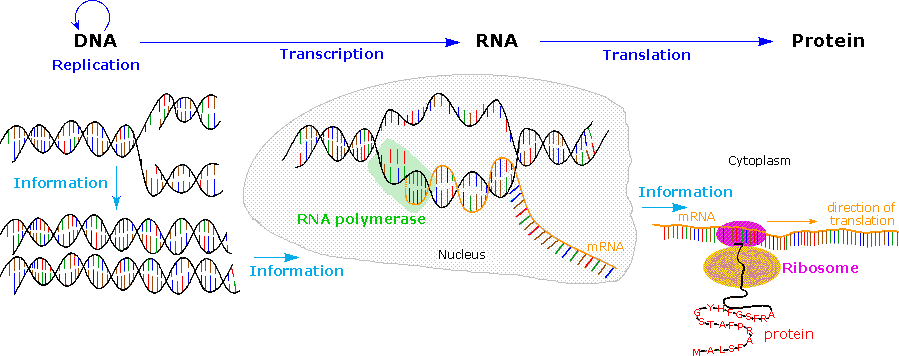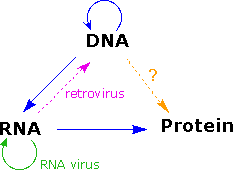


 علم الكيمياء
علم الكيمياء 
 الكيمياء التحليلية
الكيمياء التحليلية 
 الكيمياء الحياتية
الكيمياء الحياتية 
 الكيمياء العضوية
الكيمياء العضوية 
 الكيمياء الفيزيائية
الكيمياء الفيزيائية
 الكيمياء اللاعضوية
الكيمياء اللاعضوية 
 مواضيع اخرى في الكيمياء
مواضيع اخرى في الكيمياء
 الكيمياء الصناعية
الكيمياء الصناعية |
Read More
Date: 27-8-2018
Date: 27-8-2018
Date: 27-8-2018
|
Francis Crick proposed that information flows from DNA to RNA in a process called transcription, and is then used to synthesize polypeptides by a process called translation. Transcription takes place in a manner similar to DNA replication. A characteristic sequence of nucleotides marks the beginning of a gene on the DNA strand, and this region binds to a promoter protein that initiates RNA synthesis. The double stranded structure unwinds at the promoter site., and one of the strands serves as a template for RNA formation, as depicted in the following diagram. The RNA molecule thus formed is single stranded, and serves to carry information from DNA to the protein synthesis machinery called ribosomes. These RNA molecules are therefore called messenger-RNA (mRNA).
To summarize: a gene is a stretch of DNA that contains a pattern for the amino acid sequence of a protein. In order to actually make this protein, the relevant DNA segment is first copied into messenger-RNA. The cell then synthesizes the protein, using the mRNA as a template.

An important distinction must be made here. One of the DNA strands in the double helix holds the genetic information used for protein synthesis. This is called the sense strand, or information strand (colored red above). The complementary strand that binds to the sense strand is called the anti-sense strand (colored green), and it serves as a template for generating a mRNA molecule that delivers a copy of the sense strand information to a ribosome. The promoter protein binds to a specific nucleotide sequence that identifies the sense strand, relative to the anti-sense strand. RNA synthesis is then initiated in the 3' direction, as nucleotide triphosphates bind to complementary bases on the template strand, and are joined by phosphate diester linkages.
A characteristic "stop sequence" of nucleotides terminates the RNA synthesis. The messenger molecule (colored orange above) is released into the cytoplasm to find a ribosome, and the DNA then rewinds to its double helix structure.
In eucaryotic cells the initially transcribed m-RNA molecule is usually modified and shortened by an "editing" process that removes irrelevant material. The DNA of such organisms is often thousands of times larger and more complex than that composing the single chromosome of a procaryotic bacterial cell. This difference is due in part to repetitive nucleotide sequences (ca. 25% in the human genome). Furthermore, over 95% of human DNA is found in intervening sequences that separate genes and parts of genes. The informational DNA segments that make up genes are called exons, and the noncoding segments are called introns. Before the mRNA molecule leaves the nucleus, the nonsense bases that make up the introns are cut out, and the informationally useful exons are joined together in a step known as RNA splicing. In this fashion shorter mRNA molecules carrying the blueprint for a specific protein are sent on their way to the ribosome factories.
The Central Dogma of molecular biology, which at first was formulated as a simple linear progression of information from DNA to RNA to Protein, is summarized in the following illustration. The replication process on the left consists of passing information from a parent DNA molecule to daughter molecules. The middle transcription process copies this information to a mRNA molecule. Finally, this information is used by the chemical machinery of the ribosome to make polypeptides.


As more has been learned about these relationships, the central dogma has been refined to the representation displayed on the right. The dark blue arrows show the general, well demonstrated, information transfers noted above. It is now known that an RNA-dependent DNA polymerase enzyme, known as a reverse transcriptase, is able to transcribe a single-stranded RNA sequence into double-stranded DNA (magenta arrow). Such enzymes are found in all cells and are an essential component of retroviruses (e.g. HIV), which require RNA replication of their genomes (green arrow). Direct translation of DNA information into protein synthesis (orange arrow) has not yet been observed in a living organism. Finally, proteins appear to be an informational dead end, and do not provide a structural blueprint for either RNA or DNA.
In the following section the last fundamental relationship, that of structural information translation from mRNA to protein, will be described



|
|
|
|
تفوقت في الاختبار على الجميع.. فاكهة "خارقة" في عالم التغذية
|
|
|
|
|
|
|
أمين عام أوبك: النفط الخام والغاز الطبيعي "هبة من الله"
|
|
|
|
|
|
|
قسم شؤون المعارف ينظم دورة عن آليات عمل الفهارس الفنية للموسوعات والكتب لملاكاته
|
|
|